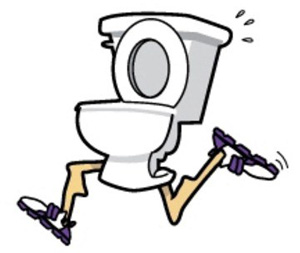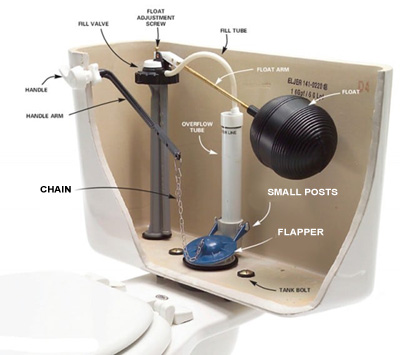Is Your Toilet Running?
By: Jim Maurer
 Has your water bill been creeping up? A running toilet or dripping faucet can double your water bill. Many times, people don’t even know these leaks are occurring. Here’s how to check for and repair these leaks that are literally causing you to flush money down the drain.
Has your water bill been creeping up? A running toilet or dripping faucet can double your water bill. Many times, people don’t even know these leaks are occurring. Here’s how to check for and repair these leaks that are literally causing you to flush money down the drain.
Toilets often have leaks that cause the toilet tank to slowly leak water down the drain, a ‘running toilet’. These leaks are often difficult to detect. Once enough water leaks out of the tank, the mechanism in the tank dutifully refills it. If you ever hear the water come on in the tank when it was not flushed, this is an indication of a leak. You may also notice a small trickle of water in the bowl, really only a small water disturbance at the top of the water. This is also an indication of a running toilet. These indications are often hard to detect, so hear is another way to test your toilet for a leak. Open the lid to the tank and observe the water level. Next, turn off the water valve behind the toilet. Now, wait six or more hours. Turning off the water valve prevents the mechanism in the tank from refilling the tank if the water level drops. After the six or more hours, open the tank and observe the water level again. If the water level has dropped, you have a running toilet.
 For most toilets, repairing a running toilet is easy and can often be done by the homeowner. A running toilet needs the flapper replaced. The flapper is a piece of rubber at the bottom center of the rear tank. It covers the hole that leads to the toilet bowl. When you flush the toilet, the flapper is raised allowing the water to enter the bowl. The flapper is made of soft rubber and seals against the bottom of the tank. When this seal leaks, water leaks into the bowl and down the drain. Most toilet flappers can be replaced with a Universal Flapper available at any hardware store. These are relatively inexpensive. Most flappers are held in place by two rubber eyelets that wrap around two small posts at the base of the large vertical tube in the center of the tank. Turn the water valve behind the toilet off and flush the toilet to empty the tank. Pull the flapper eyelets off the small post and disconnect the chain. Clean the bottom of the tank where the flapper seals over the hole. Reverse the process to install the new flapper. Adjust the chain so it only has a little slack when the flapper is down. Make sure the flapper can move freely and does not touch or rub any areas inside the tank. If your flapper looks different than described or is attached differently, you may want to hire a handyman or plumber to complete the repair for you.
For most toilets, repairing a running toilet is easy and can often be done by the homeowner. A running toilet needs the flapper replaced. The flapper is a piece of rubber at the bottom center of the rear tank. It covers the hole that leads to the toilet bowl. When you flush the toilet, the flapper is raised allowing the water to enter the bowl. The flapper is made of soft rubber and seals against the bottom of the tank. When this seal leaks, water leaks into the bowl and down the drain. Most toilet flappers can be replaced with a Universal Flapper available at any hardware store. These are relatively inexpensive. Most flappers are held in place by two rubber eyelets that wrap around two small posts at the base of the large vertical tube in the center of the tank. Turn the water valve behind the toilet off and flush the toilet to empty the tank. Pull the flapper eyelets off the small post and disconnect the chain. Clean the bottom of the tank where the flapper seals over the hole. Reverse the process to install the new flapper. Adjust the chain so it only has a little slack when the flapper is down. Make sure the flapper can move freely and does not touch or rub any areas inside the tank. If your flapper looks different than described or is attached differently, you may want to hire a handyman or plumber to complete the repair for you.
A dripping faucet can waste a lot of water too. An easy way to test for a dripping faucet is to place an empty cup under it. After a few hours, if there is any water in the cup, your faucet is dripping. Fixing a dripping faucet requires you to disassemble the faucet handles. This job is bigger than most homeowners want to tackle. A very experienced handyman could handle it, but you will most likely want a plumber. Chances are only one side is leaking, either the cold or hot side, but you will want to service both sides. If one side is leaking now, the other side may start soon. Test all your faucets including the bathroom sinks, tub/shower, kitchen sink, and outside faucets.
Your plumbing leaks may be small, you may not even know they are there, but that 24/7 drip can significantly add to your water bill. Repair the leaks and watch your water bill plunge.
Like this article? Find more articles here.
Follow us on Facebook to be notified of new articles.